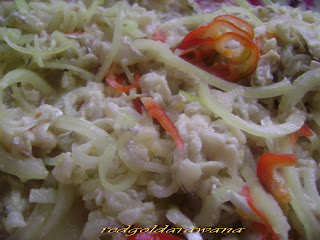I will introduce some information about my favorite food.......
Linut:
Of all the Melanau delicacies, linut is considered as the most complete dish because it is served with ulam such as herbs and vegetables plus smoked or salted fish, spicy gravy and sambal.Though it sounds a bit complicated due to the number of accompaniment and side dishes, the preparation of linut itself is very simple, only with sago flour.Appropriate amount of sago flour, depending on the number of people, is prepared by cleaning with water. Clean water is then added to the flour before boiling water is poured on the flour as it is stirred until it turns sticky like glue.
Linut is best when served hot, and that is why the accompaniment and side dishes must be prepared before hand so that the linut can served right away while it is still hot. The traditional way to scoop the sticky linut from the bowl is to use a special clipper made from the vein of the sago palm frond. Just poke the clipper into the linut and twist it around a few times and scoop the linut which sticks to the clipper.Linut is normally served during a family reunion or a gathering of friends and visitors.
Umai Jep:
Umai is made of raw fish, pounded together with norm ingredients such as onion, chili and lemon. Sometimes, grind peanuts are added. Another old version of umai is to serve it together with another local food called sago.Those familiar with Japanese “Sushi”, Umai is just a sibling of that type of raw food. Except the way it serves, the preparation of the fish is almost similar. Fish used are normally known by the locals as “pirang”, “puput” or some are using “tenggiri”. In new version of umai, some says that cuttlefish and prawn can be used as well.
Preparation of the fish is not that easy as skills and experience on using sharp knife needed to cut the fish into smaller slices. The ingredients are normally prepared separately based on the taste of the buyer. In Mukah there are two types of umai, “Umai jep” and “umai campur” the different could be seen on the type of ingredient used and how it is serve.
Jekan Lumek A.K.A Lumek Fish:
Before......
After......
During the months of March until May, lumek fishes are caught in abundance in the waters of Pulau Beruit. The fish is whitish in colour. It has razor sharp teeth with soft bones and meat. Smoked lumek fishes are produced in large quantity in the numerous huts built by the villagers. Before the fishes are smoked, the heads are removed and the fishes cleaned.A strong fire is used for the six hours smoking process in order to ensure the fishes are completely dried. Further drying under the blazing sun is required if the fishes are not completely dried.
A properly-smoked lumek fish is brownish black in colour. Once the fish is dried, it shrinks in size including its bones. Most often, the Melanau community in Kampung Betanak consumes smoked lumek together with sago or as snacks for afternoon tea.Udieng Unjur:
It is known as kupa while in some areas, it is called sesar. These dried salted shrimps are made from red hard-shell shrimps or payak. The process of making dried salted shrimps is quite complicated. The shrimps have to be shelled and straightened before they are mixed with salt. Then, the shrimps are smoked for several hours until fully dried. This is one of the reasons for its high price. Thus, it is unsurprising for a kilogramme of kupa to cost RM50.00 in Kampung Betanak while in Kuching, it is RM80.00.
So you already know little information about my favorite food,so why don't you come to Sarawak and try it yourself. I guarantee you'll want more after you eat these foods,believe me...;)





No comments:
Post a Comment